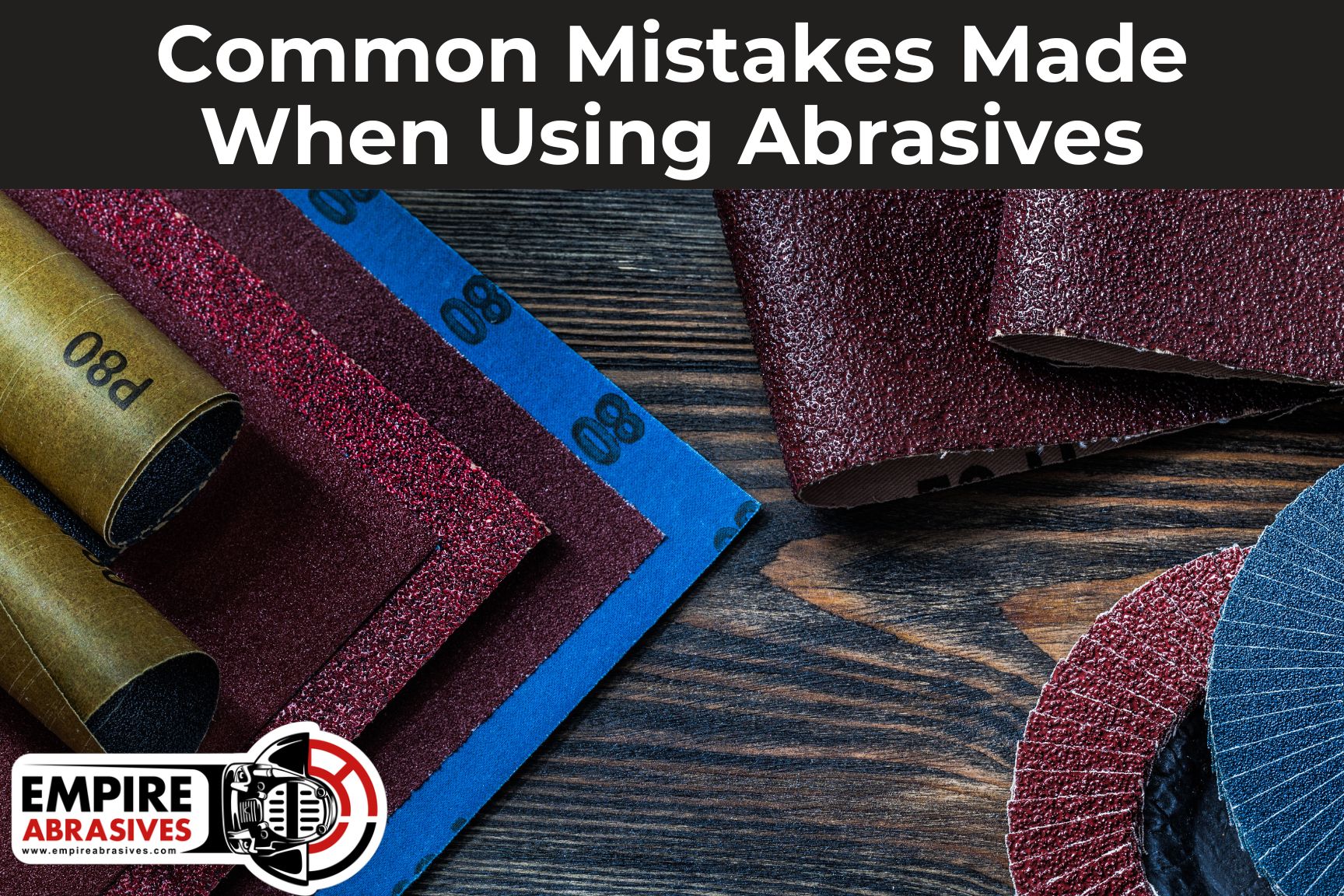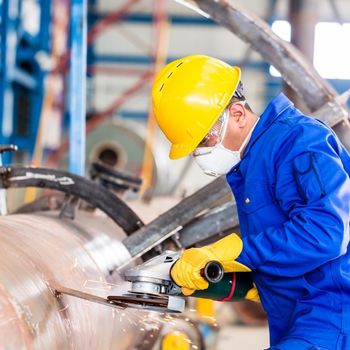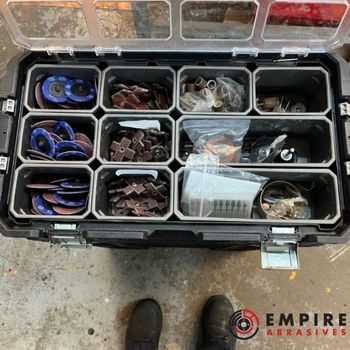
Using the right tools and equipment for a job is essential for achieving the desired results. However, for tools such as abrasives, even experienced professionals can make mistakes in their usage. Those errors can reduce these tools' effect in metalwork, woodwork, and other DIY projects.
The mistakes can include using the wrong abrasive for the job, grinding with worn-out abrasives, using excessive pressure, and ignoring safety precautions. Also, not adequately preparing the surface, not matching the abrasive to the tool, and not regularly cleaning the abrasive can cause ineffective results.
Keep reading on to understand the eight most common mistakes made when using abrasives and how to avoid them.
8 Most Common Mistakes Made When Using Abrasives
Most people use abrasives to reshape and refine surfaces. They come in various forms, such as sandpaper, grinder belts, grinding wheels, and polishing attachments. It is essential to use these tools correctly to ensure you reach the desired results.
Mistakes such as using the wrong abrasive, not preparing the surface adequately, and not matching the abrasive to the tool can significantly drain time and resources. They can also lead to inefficient results and injury if safety precautions are ignored.
Here is an elaborate analysis of eight mistakes you can avoid to get the most out of your abrasive materials:
1 - Using the Wrong Abrasive for the Job
Different materials require different methods and types of abrasives to get the best results. Using the wrong abrasives can damage the surface, producing a poor-quality finish.
For instance, using a coarse abrasive such as a low sandpaper grit on a delicate surface such as softwood could cause scratching and gouging, ruining the surface. Conversely, using a soft abrasive such as steel wool on a hard surface such as metal could be ineffective and take more time to complete the job.
Then there are other factors that should be considered like the actual abrasive grain as well as the properties of the material being worked on. For example, you wouldn’t want to use the same abrasives to grind or polish aluminum that you would use for grinding or polishing stainless steel. In this case, aluminum is a soft metal with a lower melting point than stainless steel. This could lead to destroying the surface when grinding with the wrong abrasive from heat buildup and you should use a specialty aluminum grinder wheel and specific type of aluminum polishing kit for this fragile metal.
To avoid this, you can research the best abrasives to use on the particular material. You can also refer to the abrasive products label, which usually has instructions on its suitable application.
2 - Using Worn-Out Abrasives
Worn-out abrasives can reduce the desired results and even damage the surface. It is essential to check whether the tool you desire to use is still in good condition before starting a project.
Look for signs such as clogged grains, cracks, and exposed backing to tell if an abrasive is worn out. For instance, you can get frayed sanding belts, dulled flap discs, or chipped grinding wheels.
If the abrasive is in bad condition, it is best to replace the tool with a new one. The replacement can ensure quality results and safety. You should consult a professional to help you source high-quality tools that match your needs.
3 - Using Excessive Pressure
Using too much pressure when using an abrasive can cause premature wear and tear to the tool and damage the surface.
For instance, applying too much force on sandpaper when sanding wood can cause a dip in the surface and make it uneven. Also, using too much force when grinding and cutting can cause the tool to break or cause injuries.
To avoid this, you should use enough pressure to allow the abrasive to do its job. It is also essential to control your grip and adjust the pressure for different materials. However, do not use too little pressure as it can cause poor-quality results, making the job take much longer.
4 - Ignoring Safety Precautions

Not following safety guidelines when using abrasives can be hazardous and lead to accidents. For instance, not wearing eye protection when working with a grinding wheel can cause dust and debris to get into the eye.
It is essential to always observe safety protocols when using abrasives. Wear safety gear such as gloves, goggles, and a face mask/n95 particulate respirator during the job. You can also ensure the workspace is well-ventilated to prevent dust inhalation.
Securing the abrasive tools is also essential to prevent them from getting into the wrong hands. For instance, you can use a toolbox to store the grinders where they can only be accessed by professionals with the expertise to use them.
5 - Not Properly Preparing the Surface
Surface preparation can be overlooked as the jobs you take with abrasives are usually time-consuming. However, it is essential to properly prepare the surface before using these tools. Otherwise, you can contaminate the abrasives, leading to poor results.
For instance, not smoothing rough surfaces before sanding them can lead to uneven patches. As such, it is vital to assess the surface and use a suitable cleaning material to remove any dirt from the surface.
6 - Not Matching the Abrasive to the Tool
Using the wrong abrasive for a specific tool can affect performance and lead to poor results. For instance, using a cut-off wheel on a loose grinder can cause pieces of the wheel to fly at high speeds and become dangerous projectiles. The same rule applies for abrasive product sizes. Just because you can get a 4 1/2” flap disc to fit on your 4” angle grinder does not mean you should use them together!
Also, using a flexible abrasive such as sandpaper on a rigid tool such as an angle grinder can cause the abrasive to tear and reduce its effectiveness.
To avoid this, it is suitable to match the abrasive to the tool and use it as per its instructions. You can also check with the manufacturer's instructions to find out what type of job best fits the abrasive tool.
It is also essential to check the right abrasive size for any project. For instance, using a small abrasive on a large surface can cause poor results and slow down the work process. It can also lead to premature wear and reduce the life of the abrasive tool.
7 - Not Using Proper Storage Techniques
Improper storage of abrasive tools can cause them to rust and become less effective. For instance, leaving chop saw wheels in a moist environment can cause them to warp and become unusable. As such, It is essential to store them correctly to ensure they have a long lifespan.
You can store the tools in a dry, cool place away from direct sunlight. To prevent mix-ups and misplacements, you can also use spacious and well-labeled containers for storage. It is also essential to check the manufacturer's instructions on the storage of the tool, as specific tools, such asresin fiber discs, require special storage.
8 - Not Regularly Cleaning the Abrasive and Tool
It is vital to clean your abrasive tools after every use. Not doing this can cause them to become clogged, leading to poor performance and a shorter lifespan. They can also become contaminated with residue from previous use, making them less effective on new projects.
For example, not cleaning sanding discs or sanding belts can cause them to become clogged with dust. To avoid this, you can clean the tools thoroughly with a sanding belt cleaner to ensure optimal performance.
You can also use an air compressor to blow dust and debris from the tools. However, when blowing, ensure you use protective eyewear and a face mask to avoid inhaling the dust particles.
Conclusion
Abrasive tools can come in handy in various projects, such as sanding and grinding. However, if not used properly, they can become hazardous. As such, it is essential to avoid common mistakes such as not wearing safety gear, not properly preparing the surface, and not matching the abrasive to the tool.
By avoiding these mistakes, you can ensure your safety and get the best results from your abrasive tools. You can also ensure their longevity by storing them correctly and regularly cleaning them after use.
Contact us for more information on the proper use of abrasive tools.
